|
Programs & Activities
San Carlos de Bariloche, Patagonia, Argentina
|
|
|
|
|
|
|
We have small classes starting most weeks of the year for all levels - and students tend to improve their language skills rapidly. Classes are taught using the immersion method, which is considered to be the most rapid form of language acquisition. Classes can be taken for varying number of hours per week, with 20 hours per week being the standard program, especially if you are going for more than 8 weeks. Local extracurricular activities and excursions are also an important part of the program, and conducted in the local language, as well.
|
|
|
|
|
|
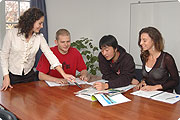 Standard Program
Standard Program
20 hours per week. The Group Program consists of 4 hours per day, Monday through Friday, of Spanish language study in a group setting with a maximum of 5 students per class. Because of the small class size students receive individualized attention allowing for maximum contact with both the Spanish language and the culture. Dates and Fees click here
Group/Tutor Combo Program
28 hours per week. This program combines 20 hours of the Group course with 8 hours of Tutor one-on-one instruction weekly. It is designed for those students who want maximum language learning and/or special vocabulary in Spanish. Close attention is paid to the individual student's goals and needs. Dates and Fees click here
|
|
|
|
|
Private Classes
20 hours per week. Get the most intensive Spanish course available with the Tutor program. Students are taught in a one-on-one setting with a private tutor for maximum immersion. This program is ideal for business professionals or anyone who has tight schedule and/or specific needs. Dates and Fees click here
|
|
|
|
|
For a sample day of a program
Day - At - A - Glance
9:00 – 10:00 Spanish Classes
10:10 - 10:55 Spanish Classes
10:55 - 11:15 Break
11:15 – 12:00 Spanish Classes
12:10 - 13:00 Spanish Classes
Note: classes might be in the afternoon too from 2:00 pm to 6:00 pm for Group or One and one classes or students could participate in the afternoon activities.
**Day-At-A-Glance is a sample day and will vary depending on enrollment, time of year, lodging, etc. It is designed to show content rather than precise scheduling.
|
|
|
|
|
Orientation:
NRCSA programs will held an Orientation session locally. The orientation designed to provide students with important information about immigration, law of the countries, and the services offered by the school. The orientation program also helps you to acquaint to the educational and cultural atmosphere and provide an opportunity to meet other students.
First Day:
With regards to the program, all levels of the language are accepted, from complete beginner to advanced, and your exact level is determined by a placement test to make sure we put you in the right class. One of the unique things about the NRSCA program is the ability to combine the language classes with an extensive choice of culture classes. In addition to the language classes, we also include our culture and social events program in the afternoons for students to interact with other student and learn about the culture.
|
|
|
|
|
Levels & Course Content
Our program is divided into 6 levels of study. The first eight are concentrated on grammar, vocabulary, practical situations, and conversation. The next levels, advanced and superior, focus mainly on conversation and advanced reading and writing topics.
NOTE: Content descriptions are examples of topics covered. Discussion topics and themes vary.
- Beginner 1: (No Spanish) pronunciation, identifying people and things, present tense, family members, "ser" and "estar", interrogative pronouns, indefinite/definite articles, greetings, demonstative adjectives, present progressive tense, "hay" and "tener", days and months, possessive adjectives.
- Beginner 2: reflexive verbs and pronouns, sports and activities, future informal ("ir" + ), preferences and desires, "nunca"/"siempre", imperative tense, ordinal numbers, "tener que", "haber", and "deber", prepositions of time and place, imperfect tense.
- Intermediate 1: relative pronouns, interrogative pronouns, "para" and "por", past perfect irregulars, future imperfect, conditional tense, present subjunctive, uses of subjunctive verbs, "seguir" and "quedar", preterite perfect "estar" + gerund, irregular subjunctive verbs.
- Intermediate 2: preterite perfect subjunctive, passive voice, uses of "se", verbs with prepositions, adverbial expressions, diminutives and augmentatives, idomatic expressions, preterite imperfect subjunctive, prepositional phrases, synonyms and antonyms.
- Advanced: advanced writing, reading, and conversation. Topics vary.
|
|
|
|
| |
|
Admissions & Academic Credit
|
|
|
|
Students age 16 years and older are welcomed regardless of educational background, occupation or nationality. Students under the age of 16 must be accompanied by an adult or have parental consent. No previous knowledge of Spanish is required except where otherwise indicated.
Students desiring credit for their study program should contact their home school or request the NRCSA Credit Fact Sheet. Generally, U.S. universities consider 15 hours of study to be equal to 1 semester credit.
For more information about academic credit in Spanish speaking countries, please click here.
For general information on academic credit, please click here.
Call us at 1-888-678-6211 to assist you with more details
|
|
|
|
| |
|
Cultural and Social Activities
|
|
|
| |
|
|
| |
|
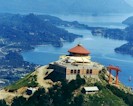 The San Carlos de Bariloche study center offers excursions and activities to the following locations:
The San Carlos de Bariloche study center offers excursions and activities to the following locations:
• Tronador Mountain and "Los Alerces" (Larch Waterfall)
• Villa Traful - Circuito Grande
• Blest Port, Cantaros Waterfall and Frias Lake
• San Martin de los Andes Town and Seven Lakes
• Cerro Otto Mountain
• Catedral Mountain
• Huemul Island in Nahuel Huapi Lake
• Circuito Chico y Llao-Llao
|
|
|
|
|
|
|
|
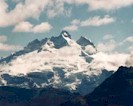 Tronador Mountain and Los Alerces Waterfall
We drive along road 258, by Gutiérrez and Mascardi Lakes, with their beautiful scenery, then leading to the wooded slopes by winding roads where we have glimpses of the east coast of Mascardi Lake which offers here a characteristic aquablue colour. We then cross the bridge over Manso River -also known as the river of the seven colours for its distinctive shades- where the road forks. After taking the road on the right we drive along the bank of the upper Manso River to Pampa Linda - a wonderful green plain- almost at the end of the drive we go through a shady forest and come to Ventisquero Negro (Black Glaciar) with its everlasting ice. The trip ends a little further, at the bottom of Tronador Mountain. From here, tourists can walk directly to the lowest parts of the glaciar. Summer Mountain climbers often come to this area, to the three peaks: the Argentine Peak 3410 mts. high, the International Peak 3554 mts high and the Chilean Peak 3430 mts high.
Tronador Mountain and Los Alerces Waterfall
We drive along road 258, by Gutiérrez and Mascardi Lakes, with their beautiful scenery, then leading to the wooded slopes by winding roads where we have glimpses of the east coast of Mascardi Lake which offers here a characteristic aquablue colour. We then cross the bridge over Manso River -also known as the river of the seven colours for its distinctive shades- where the road forks. After taking the road on the right we drive along the bank of the upper Manso River to Pampa Linda - a wonderful green plain- almost at the end of the drive we go through a shady forest and come to Ventisquero Negro (Black Glaciar) with its everlasting ice. The trip ends a little further, at the bottom of Tronador Mountain. From here, tourists can walk directly to the lowest parts of the glaciar. Summer Mountain climbers often come to this area, to the three peaks: the Argentine Peak 3410 mts. high, the International Peak 3554 mts high and the Chilean Peak 3430 mts high.
We drive back along the same road and at the forking of Manso River bridge we take the road to Alerces Waterfall. Driving along the coast of Los Moscos Lake, we arrive to Hess Lake, a beautiful, quiet spot and finally to the waterfall. This last part of the Alerces falls look-out is on foot. A walk of 300 mts. through a wood path -a forest of larches- and going by the river bank we arrive to the fall where its waters furiously flow down between high rocks. This area of Nahuel Huapi National Park delights visitors with its untouched scenery where nature unfolds its pristine beauty, a memory that will last.
|
|
|
|
|
|
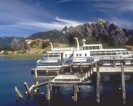 Blest Port, Cántaros Waterfall and Frías Lake
Blest Port, Cántaros Waterfall and Frías Lake
We go by bus along Bustillo Avenue (the lake road) to Pañuelo Port in Llao-Llao area, on the Nahuel Huapi Lake. There we board the ship that sails on Brazo Blest (Blest Fiord) to its end, where Blest Port is located.
The boat trip is an unforgetable experience, from the blue water of the lake to the beautiful outline of the mountainous National Park, its beaches around the lake and the thick vegetation of different shades of green. The seagulls fly accompanying the boat and even eating bread crumbs from the tourists' hands. We sail by Centinela Island, the burial site of Perito Moreno who was the first person to explore the area and who later donated his lands to create the Nahuel Huapi National Park. The landscape along Blest Fiord resembles the Norwegian Fiords.
We then arrive to Blest Port, an area of dense vegetation on account of its extremely humid climate.
From there we take a bus to Frías Lake where the water has a very special shade of green. Then we arrive at Puerto Alegre where we board a boat and sail on this lake. This offers a beautiful view of Tronador Mountain; we sail by Pared del eco (The Echo Rock Wall) to Frías Port and then return to Blest Port going on to Cascada Los Cántaros (Pitchers' Waterfall). From here, we climb up the steps of 600 metres path leading to three belvederes on the sides of the waterfall which offer very beautiful sights of different smaller falls.
We can admire all along this climb the splendid native species and valdivian rain forest -coihue trees, colihue canes, cypresses, climbing vines and lianas. At the end of the path we get to the Pitchers' Pond, the source of the waterfall, 852 mts. above sea level and a pond which generally freezes during winter months. A few metres away from the coast we find a very old larch tree specimen (Fitzroya Cupressoide) 1500 years old.
We then take the boat back and return to Bariloche.
|
|
|
|
|
|
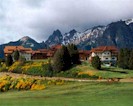 Circuito Chico and Llao-Llao Excursion
Circuito Chico and Llao-Llao Excursion
This trip starts on Bustillo Avenue, leaving from Bariloche town; the bus drives along the Nahuel Huapi lake coast road. When we arrive to km.8 we go by Playa Bonita ("Beautiful Beach") a place close to the town and generally chosen by local people to enjoy the beach and sun-bathing. From here we can see Huemul Island and the mountains on the opposite side of Nahuel Huapi Lake. At km. 18 we go by the slopes of Campanario Mountain and San Pedro Peninsula. As we drive along the lake road -bordered by pine forests and wild flowers- we arrive to Llao-Llao Hotel (photo on the right) built on a wonderful and unique site for its mountain and lake landscapes. Lakes Moreno and Nahuel Huapi waters bathe its huge gardens.
St. Edward's Chapel is found here -a beautiful example of the local arquitecture- as well as Puerto Pañuelo, starting point of most lake trips of this area. Always along the road, we notice how local flora and fauna envelope us, with trees more than thirty metres high, then we come to the bridge joining Moreno and Nahuel Huapi Lakes, at the bottom of López and Capilla Mountains with their looming, vertical rising slopes. Further on, we stop at a natural look-out spot offering an incredible view of the surrounding landscape, we cross the bridge built on the narrowest part of Moreno Lake, where we find log cabins and houses with the typical arquitecture of this area. We stop at El Trebol pond (Clover Leaf pond) which owes its name to the particular shape of its coastline, and then we drive back to Bariloche all along the lake road.
|
|
|
|
|
|
|
|
|
|

